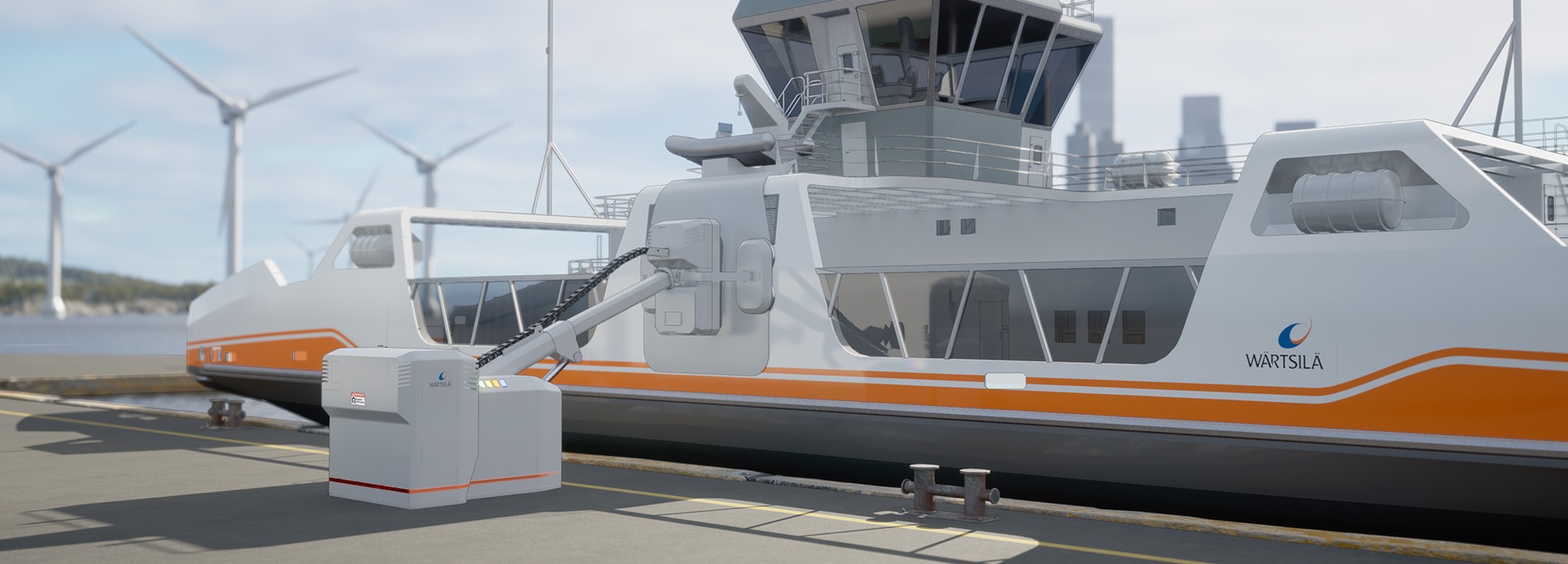

Full electric, battery powered ships
Full electric vessels get all their power from batteries – for propulsion as well as auxiliaries. Battery power onboard and charging infrastructure onshore enable zero carbon operations. This makes electric, battery powered ships an interesting concept – after all, decarbonisation is high on the agenda of governments and regulatory bodies. Electric ships will become more common and the capabilities are increasing fast.
The efficiency of an electric propulsion system can be as much as 90% due to the low loss from the system and is being adopted by many vessel types.
Battery powered ships – how do they work?
Full electric vessels operate without an internal combustion engine. Batteries provide the power for the ship.
In contrast, a hybrid ship resembles a plug-in hybrid car in that it will charge its battery using shore power, and it also has a conventional engine onboard.
Because batteries are heavy, a fully electric drive is practical for vessels that sail shorter distances. For vessels that sail longer distances, a hybrid solution is more suitable.
Ferries, tugs, and inland waterway vessels can easily benefit from full electric propulsion. Already, some inland vessels such as ferries and pleasure boats sail using nothing but electricity. This is because they sail shorter distances and can therefore operate on smaller batteries, which weigh less and are faster to re-charge.
As a technology leader in vessel electrification, Wärtsilä is investing in and developing solutions to support this important and growing segment of marine vessels. Here are three vessel types that are likely to take advantage of the latest developments.
Full electric ferries
Ferries are part of the local infrastructure and day-to-day life of local communities. As a rule, they will dock at certain locations at regular intervals. Full electric propulsion is a valid solution for them for short distances.
Although the onboard electric propulsion system may be simple, the onshore charging infrastructure is not. A ferry may have a short turnaround time, meaning that it will have a limited time to re-charge its battery.
If the local grid is weak, there has to be an energy storage system onshore for buffering electricity – to allow faster charging at higher power levels.
Electric ships powered by batteries are becoming more and more interesting for companies who want to be more sustainable. One interesting example is a new ferry being built by Incat Tasmania, ordered by Buquebús.
Another example are the two zero-emissions ferries for Norwegian operator Boreal Sjö. The ship design is tailored to the operating and route profiles of the two double-ended shuttle ferries.

Full electric tug boats
Tugs are critical to the safe entry and docking of many vessels in ports. They have a clear operating pattern: transit to a vessel – light assist most of the time – heavy assist when needed – transit back to the docking area. They also have enough time at dock for charging the batteries.
This is an ideal operating profile for full electric operation. The tug spends only around 3-4 hours at sea at a time, and only needs short bursts of high power when in heavy assist mode.

Electric inland waterway vessels
Inland waterway vessels also have the advantage of regular docking, but their operating pattern is different from that of ferries or tugs. Instead of sailing a few hours at a time, inland waterway vessels run 24/7 until they reach their destination. The destinations vary according to their cargo and schedule.
Swappable energy storage systems (containerised battery packs) are an ideal solution for inland waterway vessels. The swappable battery containers are stored and re-charged in locations along the waterway. The vessel can swap its battery when needed, or at the same time that it stops to load or unload cargo.
Watch this video to learn more about a mobile battery container solution for inland waterway vessels.
Battery power onboard – a great way to reduce emissions
Going fully electric is one great way for to cut harmful emissions from vessels. It is not the only way! You can find all of 50 great ways the maritime industry could cut its greenhouse gas emissions in a fascinating eBook!
Are there battery powered cruise ships? Or battery powered cargo ships?
Several boat builders are planning hybrid cruise ships. But for large cargo ships that sail the world’s oceans, electric drives are still a long way away. The batteries are still not efficient enough and are too heavy for ships that sail long distances on the high seas.
Insights on full electric vessels
Several boat builders are planning hybrid cruise ships. But for large cargo ships that sail the world’s oceans, electric drives are still a long way away. The batteries are still not efficient enough and are too heavy for ships that sail long distances on the high seas.
Electrifying marine transportation will help reduce greenhouse gas emissions, improve air quality, and create a healthier environment for all.
All vessel types and operating profiles that can become fully electric will eventually migrate to this fast developing, technology driven propulsion solution.
Take advantage of the unique expertise that Wärtsilä teams can offer - get in touch and let’s discuss your needs and options!


